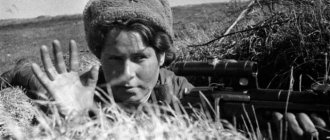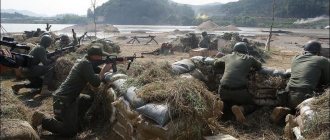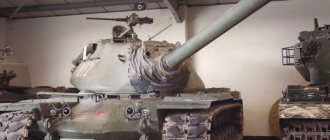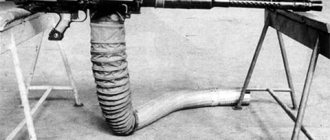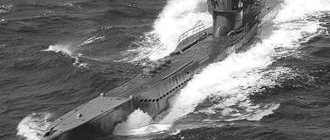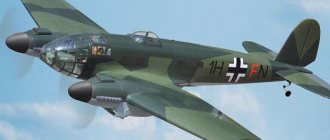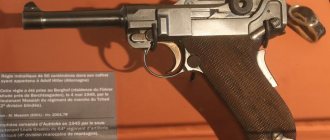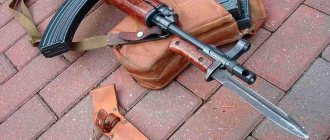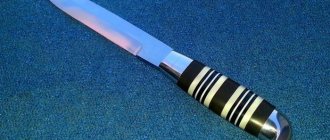History of military weapons
Back in 1904, during the defense of Port Arthur, Russian officers S. Vlasyev and L. Gotyabo created an unusual artillery weapon with a short tube-shaped barrel. The 47-mm naval gun was intended for mounted firing at enemy targets. The flight range of such an installation was small, only 400-500 meters.
Subsequently, World War I mortars were used as an effective means of trench warfare. However, over time, it was this improved invention that became a formidable weapon. World War II mortars caused a lot of trouble for German soldiers.
The mortar received its modern shape thanks to the first sample of the Stokes design. This is a pipe-barrel on a two-legged monitor support, resting on a flat metal plate, which dampens the recoil of a shot into the ground.
Several years before the war with Germany, the Soviet government began to persistently launch mass production of inexpensive and easy-to-maintain artillery weapons, believing that they would replace a whole range of artillery weapons. For this reason, the production of the Taubin automatic grenade launcher was suspended, which, during tactical tests in 1937, established itself as an excellent mounted combat weapon.
Stability and speed
The "Sani" mortar is designed to engage enemy personnel and fire weapons located in engineering structures and hard-to-reach areas - for example, on reverse slopes and in deep gorges.
The destruction is carried out by 120-mm high-explosive fragmentation mines. If necessary, military personnel can use smoke, illumination and incendiary ammunition, as well as the KM-8 “Gran” guided weapon system, which allows you to destroy stationary and moving targets with the first shot without zeroing.
Also on topic
Accuracy, maneuverability and firepower: how is the development of the promising self-propelled howitzer "Coalition-SV" progressing? The first batch of self-propelled howitzers on the wheelbase "Coalition-SV" is being tested at the Burevestnik Central Research Institute. According to experts, the new...
The mortar is transported in the back of a Ural-43206 off-road truck or towed. The weapon can also be transported by the MT-LB multi-purpose transporter-tractor. Unloading from the vehicle is carried out using a winch equipped with an electric drive. This greatly facilitates the crew’s work and reduces the time it takes to deploy the gun on the ground. The 2B11 is delivered directly to the firing line by wheel.
Preparing to fire from the Sleigh usually takes 1.5-2 minutes. The mortar is mounted on a special plate, which provides all-round firing from various soils, including hard and frozen ones.
“Thanks to the significant power of the mine, sufficient rate of fire, maneuverability, range and accuracy of combat, the modernized 120-mm mortar system 2S12A is capable of effectively and timely performing various tasks during combat operations,” says UVZ materials.
General Director of the Central Research Institute "Burevestnik" Georgy Zakamennykh calls the brainchild of the enterprise one of the world's best examples in this class of weapons. According to him, thanks to the Gran complex, the mortar is capable of hitting targets at a range of up to 9 km. He cited increased stability and towing speed as the advantages of the modernized “Sleigh.”
In an author’s article in the National Defense magazine, Zakamennykh said that the mortar complex received an improved all-round firing plate, a quick-release firing mechanism, a set of lighting equipment for firing in the dark that does not require recharging, as well as a number of other improvements. The safety of the calculation is ensured by a fuse of low mass and increased reliability.
“Due to the placement of the 2B11 mortar on modern wheeled (Ural-43206) and armored tracked (MT-LB) cross-country chassis, the mobility and security of the crew and ammunition have been increased. The mortar loading and unloading processes are mechanized thanks to the complex being equipped with an electric winch. This made it possible to reduce labor intensity, the time to deploy a mortar at a firing position, including a reduced crew, and the time to change positions,” Zakamennykh emphasized.
- Soldiers fire from a 2B11 gun
According to the Russian Ministry of Defense, the “Sleigh” showed high efficiency during combat operations in mountainous areas. During exercises and training, military personnel often practice shooting from indirect firing positions at maximum range at buried single and group targets.
To complicate the task of defeating a mock enemy, the military sets targets on hills and reverse slopes of mountains. To navigate the terrain, Sleigh crews must use only a map, compass and binoculars.
Russian troops are also mastering the tactics of “roaming” mortars, intended for defensive operations. It lies in the fact that the “Sleigh” crews are located not as part of platoons, but separately, and they constantly change positions. In this way, the enemy is deceived as to the system of fire and the number of forces available.
In addition, Sanya crews constantly practice interaction with units equipped with more powerful artillery systems - 122-mm Akatsiya self-propelled howitzers, 152-mm Msta-S and Msta-B guns, 122-mm salvo rocket systems fire "Grad" and 220-mm "Hurricane".
Shovel mortar 37 mm caliber
In 1938, a light 37-mm mortar was developed specifically for infantry units. The author of the combat unit was M. G. Dyakonov, a famous designer of explosive devices and ammunition for artillery. In addition, he developed: the RGD-33 hand grenade and a rifle grenade launcher.
In field conditions, a 37-mm mortar could be compared to an ordinary shovel. This type of weapon was fired using fragmentation mines. Dyakonov’s mortar received its baptism of fire in the Finnish campaign.
Unfortunately, the firing range and accuracy of this weapon left much to be desired. Due to the low effectiveness of the 37-caliber mortar, it was decided to discontinue production and remove it from service with the Red Army. But life decreed differently. The use of mortars in World War II of 37 mm caliber found its application. In the winter of 1942, thanks to the fire support of Dyakonov's mortars, paratroopers of the 4th Air Corps successfully landed in the area of the city of Vyazma.
Tactical and technical characteristics of the 37 caliber mortar:
- The caliber of the gun is 37 mm.
- Weight – 2.4 kg.
- The mine's flight speed is 65-70 m/s.
- Minimum range – 60 m.
- The maximum flight range of the mine is 250 m.
- The weight of the projectile (mine) is 0.5 kg.
Notes
- Team of authors.
Volume 5, article “Artillery Mines” // Soviet Military Encyclopedia / Ed. A. A. Grechko. - M.: VoenIzdat, 1978. - P. 311. - 686 p. — 100,500 copies. - (unavailable link). Retrieved February 23, 2022.
- Team of authors.
Chapter 2.3. Shells // Artillery weapons. Fundamentals of device and design / Ed. Zhukova I. I. - M.: “Machine Building”, 1975. - P. 46. - 420 p. — 3500 copies. - ↑ Team of authors.
Volume 1, article “Artillery mine” // Military Encyclopedia / Ed. P.S. Grachev. - M.: VoenIzdat, 1997. - P. 257-258. — 639 p. — 10,000 copies. - ↑ Team of authors.
Volume 5, article “Mortar shot” // Military Encyclopedia / Ed. P.S. Grachev. - M.: VoenIzdat, 2001. - P. 149. - 575 p. — 10,000 copies.
Company mortar manufactured in 1938 and 1940. (caliber 50 mm)
Serial production of this artillery gun was started by the military industry of the Soviet Union in 1939. The developer is an experimental design bureau headed by B.I. Shavyrin. Schematically, the mortar is arranged in an imaginary triangle. The barrel-pipe and the carriage biped with a lifting mechanism were one side of this triangle, and the third imaginary side was the line between the support and the carriage.
Characteristics of a 50-mm caliber company mortar manufactured in 1938:
- Caliber - 50 mm.
- Weight – 17 kg.
- The mine's flight speed is 95 m/s.
- The maximum shot range is 800 m.
- Rate of fire – 32 rounds per minute.
- The weight of the projectile (mine) is 0.85 kg.
Subsequently, the design was improved at the V. N. Shamarin Design Bureau. And in 1940, a new version of the 50-mm mortar mount was released. As of June 22, 1941, 50-mm mortar guns became widespread in the Red Army, their number reached about 24 thousand units. These mortars of the Second World War were not particularly popular.
By the end of 1943, few military units used this type of weapon. The reason was the fact that the short firing range reached only 800 meters, which forced the mortar crews to get as close as possible to enemy positions. Due to this, combat units suffered multiple losses in manpower. This type of mortar launcher was especially popular among the partisans, who used it in their arsenal until the end of the war.
150-mm six-barreled rocket mortar Nb.W 41 mod. 1941 (Germany)
| A country: | Germany |
| Type: | Rocket mortar |
| Date of issue: | 1941 |
| Calculation: | 4 people |
| Caliber: | 150 mm |
| Length: | 1.3 m |
| Width: | No information |
| Weight: | 540 kg. (without charges) |
| Rate of fire: | a salvo of 6 shots in 10 seconds, it takes about a minute and a half to reload and prepare for the next salvo |
| Firing distance: | 6.9 km in range |
| Initial projectile speed: | No information |
| Ammunition: | 6 rocket mines |
Battalion 82mm mortar
In 1936, a mortar launcher developed at the Leningrad SKB-4 under the leadership of D.I. Shavyrin was adopted by the Red Army. The 82-mm mortar had its baptism of fire in the battles at Khalkhin Gol, establishing itself as a reliable military weapon capable of hitting enemy targets at long distances. Subsequently, these artillery pieces were modernized.
Thus, new modifications of the 82-mm mortar appeared annually throughout all hostilities. These World War II mortars served faithfully for many years to come. Not a single military operation of the Soviet troops was complete without these weapons.
The successful use of mortars in World War II of this caliber led to their becoming the prototype for a lightweight version of the 1981 Model Tray mortar.
Mortars and guns
There are several reasons why mortars became widespread, and all of them are important. This type of weapon is characterized by relative lightness, simplicity, manifested both in manufacturability and maintenance, high destructive power and the ability to cover a target from above, directly from the sky, that is, from the direction of least protection. A howitzer or mortar is used to fire along an overhead trajectory. An artillery gun weighs more, is more complex and costs the defense budget a larger sum. Guns, of course, have their advantages, such as increased range, caliber and accuracy, but under certain conditions, which arise quite often in battle, these advantages are offset. The line between two common large-caliber weapons is almost completely erased by the Cornflower mortar, the photo of which transparently hints at its “kinship” with guns. Depending on the position of the barrel, it becomes similar to a mortar, a howitzer and a regular cannon firing flatly. If we add a high rate of fire to this interesting property, then the uniqueness of the weapon becomes obvious.
Weapons of the Wehrmacht
German mines of the Second World War for mortars were made in various calibers, since the combat arsenal of Wehrmacht mortar installations had several modifications - 50-mm and 81-mm models of 1936 and 1932, respectively.
In some technical characteristics, the Wehrmacht mortars were superior to their Soviet counterparts. However, this did not help the German troops fulfill their main task - to win the war. It is noteworthy that captured German 81-caliber mortars of World War II were used by the Soviet army even after the victory. By the way, until 1955.
World War II rocket launchers
The Germans learned that the Red Army had weapons of unprecedented power at the very beginning of the war.
For the first time, a combat unit of rocket mortars under the command of Captain Flerov launched a massive attack on the Orsha junction station on July 14, 1941. According to the testimony of the surviving Nazis, a real firestorm hit the railway junction. The battery of rocket launchers struck not with simple shells, but with incendiary mixtures. The ground under the German soldiers and officers was burning under their feet.
The fame of the famous "Katyusha" instantly spread throughout the entire front. People in the rear knew about it too. The whole country made mines for mortars of the Second World War. The single motto for the entire population was: “Everything for the front, everything for victory.”
Question about the originality of the design
There is an opinion that this mortar is “no more than a copy” of the French Brandt mortar of the 1935 model (Mortier Brandt de 120 mm mle 1935). However, the Germans, who willingly accepted all captured equipment of any merit, in the case of the 120-mm Shavyrin mortar, immediately after familiarizing themselves with it, accepted it and its ammunition for mass production, thanks to the slightly increased barrel length, the German mortar had a larger (by 550 m) firing range.
All classic mortars of the 1930s were copies or modernized versions of the French Stokes Brand mortar of the 1927 model, a copy of which was given to the Soviet Red Army in 1928 in northern China. At the beginning of World War II, the Wehrmacht had 105 mm mortars (10 cm Nebelwerfer 35) in small quantities.
Large-caliber mortars (90 and even 150 mm), starting from 1935-1936, were in service in Japan. Undoubtedly, these mortars were also known to German specialists earlier than the Soviet one; but, like the French version, they did not arouse the desire to copy them.
All these mortars have common design features: an imaginary triangle design, a massive base plate (round for the Soviet design, rectangular for the French and Japanese - which already casts doubt on the version of copying the Soviet model from the French or Japanese). But these signs are too general and are inherent in the vast majority of mortars in general.
However, Japanese mortars (and, most likely, the obscure French one) were a reflection of the concept of the First World War. They were created as powerful short-range weapons, so their range remained at the level of battalion mortars. This is a weapon of trench warfare.
Secret "Katyusha" - mortar of the Second World War
The main rule of guards mortars is the hidden occupation of combat positions. Move only in cloudy weather or at night so that the enemy cannot detect. In case of encirclement, everything was also thought out. Each vehicle was mined; at the slightest threat of capture, the installation had to be blown up. It was under such circumstances that Captain Flerov’s battery died along with its commander.
In 1942, the Germans still managed to capture a combat vehicle, but they never succeeded in creating a weapon like the Katyusha. The Soviet military industry constantly increased the production of rocket mortars.
Allied help
Since 1943, Soviet jet mortars of the Second World War were installed not only on domestic ZiS-6 trucks and STZ-5 tracked tractors, but also on Ford, Austin and Studebaker off-road vehicles received under Lend-Lease. New ammunition was also developed for Katyushas.
In particular, the rocket launchers received huge 300-mm projectiles. They were intended for well-fortified defensive structures. As a rule, Katyusha rockets hit squares. However, there have been cases when launchers had to be used for other purposes.
Mortar 2B9 Vasilek - video
https://youtube.com/watch?v=9JwgbkqJ_Xo
Typically, the 2B9 is mounted on a light wheeled carriage, reminiscent of a light field gun carriage, equipped with frames and a tray. In the middle, the barrel is fixed in a rotating device, similar to a drum, which acts as a machine. The magazine-type ammunition receiver supplies 82 mm mines from clips of four mines inserted on the right. The 2B9 can fire along a steep trajectory like a mortar, with the mines being loaded manually from the muzzle, or automatically fire along a flat trajectory like a light anti-tank gun (there is a sight for direct fire) using breech loading from a magazine. To top it all off, when muzzle loading there are three different types of propellant charges, but when loading from the breech the charge is uniform. The recoil force is absorbed by a hydraulic shock-absorbing system installed around the barrel.
The 82-mm Vasilek mortar is also installed on self-propelled chassis; the most common is installation in the back of a 2-ton GAZ-66 4x4 truck. Another option is to install the Vasilka on the cargo platform of a suitably modified MT-LB tracked transporter. Hungary produces a similar version of a self-propelled gun, also assembled on the chassis of an improved MT-LB transporter.
2B9 "Vasilek" is capable of firing standard 82 mm mortar ammunition; The weight of the mine is about 3.1 kg. A special mine with a cumulative warhead has been developed for direct fire at armored targets. The maximum range when firing along a mounted trajectory is 4200 meters.
Modifications
2B9 - basic modification with water-cooled barrel (casing with water)
2B9M - modification with air-cooled barrel - no casing, the barrel walls in the middle part are thickened and have ribs
The 2K21 system is a mobile mortar complex, which includes a transport vehicle (can also be used to tow a mortar when changing firing positions and in emergency situations) 2F54 (a modified army medium off-road truck GAZ-66-05) and the mortar itself
2B9M on the MT-LB chassis (USSR) - military modification of the 2B9M into a self-propelled mortar
2B9M on the MT-LB chassis (VNR) - a slightly modified factory modification of the 2B9M into a self-propelled mortar on the same chassis
Type 99 (export designation for modification of caliber 81.2 mm - W99) - version 2B9M manufactured in China, adopted by the PLA in 1999
The 82-mm self-propelled mortar 2B9M based on the BMP-1 is a Kazakh development; one demonstration copy was presented in May 2014 at the KADEX-2014 arms exhibition. The mortar is openly installed in the middle part of the BMP-1 hull
Urban warfare
For example, during the Vistula-Oder offensive operation, in order to break through the 8-meter walls of the Poznan citadel, charged high-power projectiles were rolled into launchers for direct fire. The Katyusha's firing range was four and a half kilometers, but at direct fire it was only one. Shooting at a shorter distance was simply impossible.
Nevertheless, the mortar guards managed to adapt their formidable weapons for street fighting. From Moscow to Berlin, the Guards "Katyusha" - a mortar of the Second World War - took an active part in all combat operations.
By the end of the war, the BM-13 became a weapon of mass destruction. The first official fireworks display in the Great Patriotic War took place in August 1943, in honor of the liberation of Orel and Belgorod. It became an echo of the first volleys of Katyusha rockets in July 1941.
Interesting Facts
It is known that mortars from the Second World War destroyed not only ground targets.
In 1942, during the defense of Sevastopol, junior lieutenant Vladimir Simonok shot down a German Junkers flying low over the positions of Soviet troops with a direct hit from an 82-mm mortar. This was the only time during the entire Great Patriotic War when a mortar crew hit an enemy air vehicle. For this fantastic shot, junior lieutenant Vladimir Polikarpovich Simonk was awarded the title of Hero of the Soviet Union. Unfortunately, the lieutenant died in the same year, 1942, defending Sevastopol.
War statistics
It is interesting to compare how, in quantitative terms, the USSR mortars of World War II were produced in comparison with other countries. So, the numbers:
- The United States of America produced about 111 thousand units of military equipment between July 1940 and July 1945.
- Over the entire period, which is 1939-1944, the British military industry produced 97 thousand artillery weapons of this class.
- From the beginning of 1941 to the middle of 1944, Germany managed to equip its army with almost 70 thousand mortar launchers.
- From July 1, 1941 to June 30, 1945, the Soviet Union produced 348 thousand mortar artillery mounts of various calibers.
These figures indicate that the USSR mortars of World War II were very popular and made an invaluable contribution to the victory over Nazi Germany.
Victory tactics
Soviet reports are replete with phrases:
- in the battles for Perekop in 1944.
- Sandomierz bridgehead. Mitava, battery:
Usually, the commanders of mortar batteries walked along with the advancing infantry - and therefore, moving one battery after another, they could continuously support it with fire. An invaluable service.
120 mm mortar in Breslau
In March 1945, Guard Senior Lieutenant Fedorov with an OP noticed flashes of gunfire and shell explosions ahead. These were two German self-propelled guns, which from a very advantageous position fired at the only road and slowed down an entire infantry regiment.
Fedorov decided to open fire on them. 120-mm mines could damage the self-propelled guns' chassis or at least force them to leave their positions.
To divert the attention of the Germans, the battery fired four mines at a separate house, and from there made adjustments and fired a series of six mines at self-propelled guns. One gun ran away, the second, having traveled a hundred meters,
One gun ran away, the second, having traveled a hundred meters,
— a high-explosive mine damaged his chassis. The German infantry also ran after the self-propelled guns.
Watching the retreating enemy, the mortars discovered and covered a convoy of 25 carts. The entire regiment safely went on the offensive.
Some modern experts write that
And according to documents, in Berlin the enemy was hit with weighted 120-mm mines with delayed-action fuses. Such a mine
A 120mm mortar crew fires in Berlin
Heavy mortars, often standing just 400 meters from the Germans, covered the retreating infantry, laid smoke screens, and destroyed snipers and observers.
On Copenhagener Strasse there was a tank around the corner of the house and did not allow anyone to get to the barricade. The very first mortar raid drove the tank into cover - and then three Soviet self-propelled guns demolished the barricade and opened the way.
Soviet mortar men in Vienna
By the way, the Soviet mortar even found its way into modern American science fiction:
A truly unique weapon!

